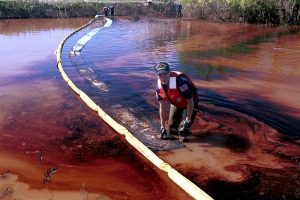Spill Response: A Guide to Using Absorbents
One of the most popular products in our range of spill response and liquid containment equipment are absorbents. SpillShop supplies polypropylene absorbents, including absorbent booms, pillows, and oil absorbent pads, to our clients across Australia and South-East Asia. Absorbents are an invaluable piece of spill response equipment for your facility, and come in various grades to suit different types of spills.
Not sure which absorbent your company needs or how to use them during a pollution incident? Our guide will take you through the different types of polypropylene absorbents, the benefits of having absorbents on hand in the event of a spill, and how to use absorbents as part of your spill response procedure:
Types of Polypropylene Absorbents
At SpillShop, we stock three types of polypropylene absorbents: absorbent pads, absorbent booms, and absorbent pillows.
Absorbent pads are primarily used to absorb spills and clean up the site of an incident, and are an integral component in our spill kits. An oil absorbent pad is ideal for the final clean-up stage of a spill, able to soak up any liquid left on surfaces, machines and your hands.
Absorbent booms (also called socks) can be used to contain spills on both land and water. The purpose of booms is to act as a containment barrier for spills. They are often used in conjunction with granular absorbents on land to form a temporary berm. For oil or fuel spills on water, marine booms offer the best results.
Absorbent pillows are used to absorb large amounts of fluid quickly. Their large surface area allows for a more efficient absorption rate, and they are an effective first response measure to a pollution incident with a large volume of liquid. Pillows can be placed in hard-to-reach areas such as under machines or in tight corners. They can also be used as temporary drain covers or plugs, or placed under leaks or drips as a semi-permanent spill control measure.

Benefit of Absorbents in a Pollution Incident
Absorbents are one of the most crucial pieces of equipment for dealing with a pollution incident. The efficiency of polypropylene absorbents makes them suitable for use in a wide range of industries including the energy, mining, oil and gas sectors, construction sites, workshops, and manufacturing facilities. Polypropylene in its raw, meltblown state has a high capacity for absorbing liquids, which is why this material is the foundation of the absorbent industry.
Absorbents, like our spill kits, come in three grades: general purpose, oil and fuel, and chemical. General purpose and chemical polypropylene absorbents are typically used on hard surfaces, while oil and fuel absorbents can also be used for water-based spills. General purpose absorbents can be used on a range of liquids including oils, fuel, solvents, mild alkalis and acids, and water, while chemical absorbents can absorb aggressive chemicals. Fuel and oil absorbent pads are hydrophobic, meaning that they float on water rather than absorbing it. Meltblown absorbent pads offer great absorbency; dimpled absorbent pads offer increased strength and are tear-resistant.
How to Use Absorbents in the Case of a Spill
Absorbents should be included in your emergency spill response procedure to help contain and absorb the spill. An uncontrolled spill cannot be easily contained and cleaned up. Therefore, your priority in the case of a pollution incident should be to isolate the source of a spill and then contain it as quickly as possible, to prevent the spill reaching a drain or water source.
Depending on the components of your spill kit, you may have absorbent mini-booms, oil absorbent pads, or pillows to use on the spill. For pollution incidents on hard surfaces, mini-booms can be wrapped around machines, damaged containers, or used as drain barriers. On water marine booms are an effective containment measure, while also absorbing the oil or fuel on contact. Ensure that absorbent booms overlap at the joints to form a leak-proof seal, and are used with granules on land to stop the spill spreading further.
Once the spill has been contained, absorbent pads and pillows can then be used to absorb and clean up the liquid. Because of their durability, size, and loose fill, absorbent pillows can significantly reduce clean-up time, while many absorbent pads are high loft for rapid absorption and better fluid retention.
To learn more about what spill response equipment your facility should have on hand in the case of an emergency, see our guide to safety equipment.
For more information regarding polypropylene absorbents or the rest of the SpillShop product range, visit our FAQ page or Contact Us directly to discuss your needs further.


